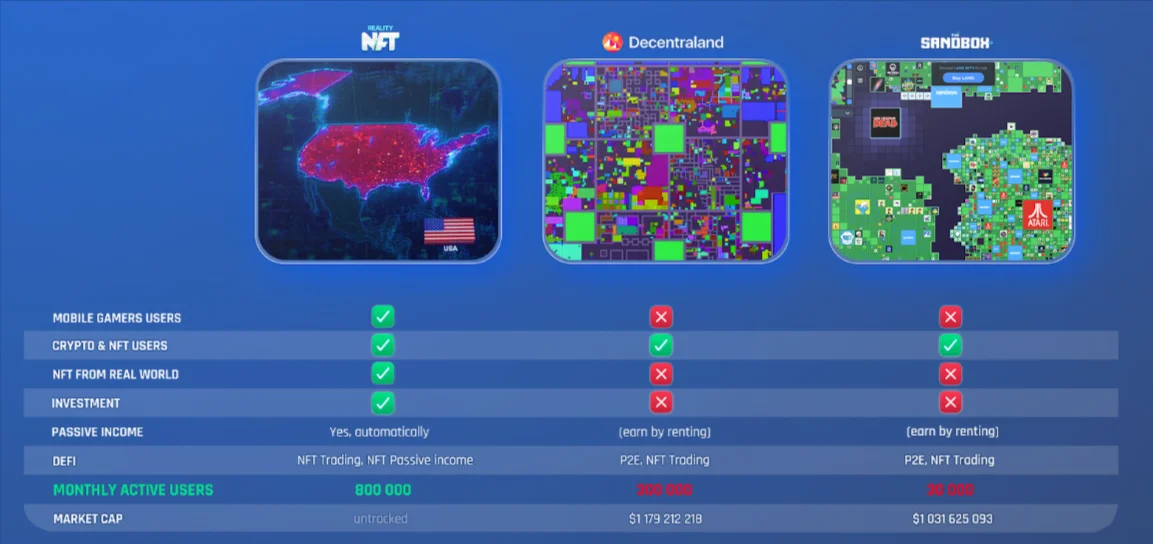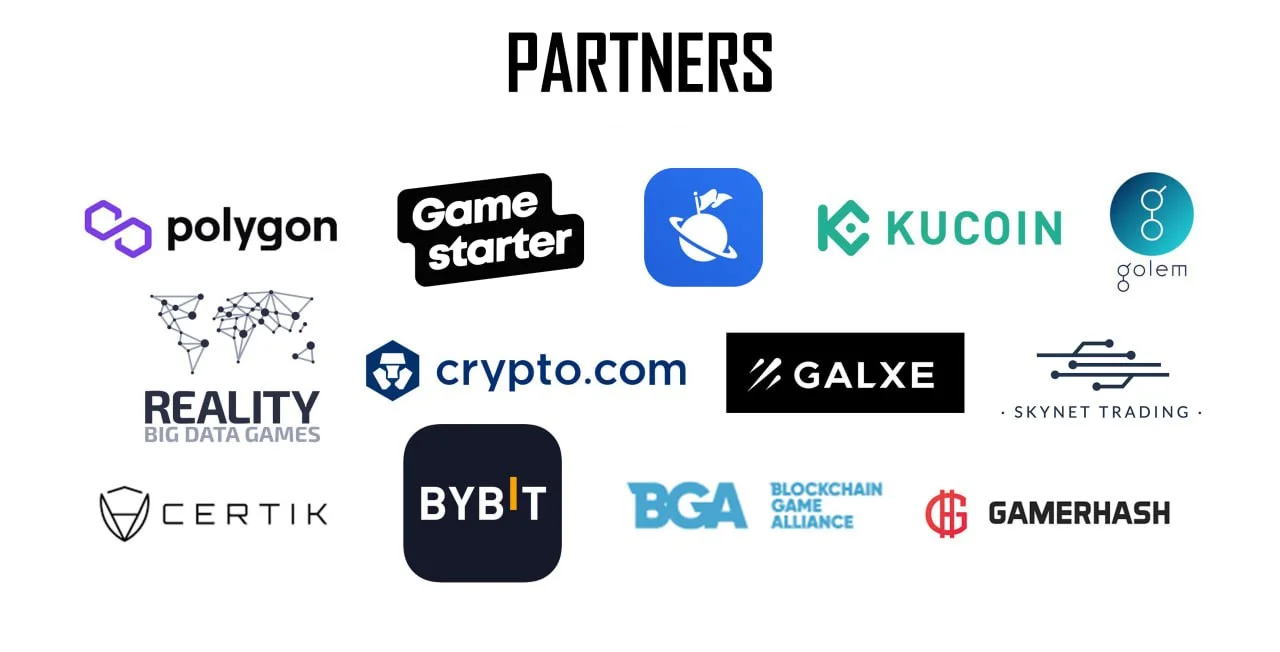75.0k
40.0M
Completed
Reality Metaverse
Completed
1. Complete KYC
2. Buy $GAME
3. Stake $GAME
4. Select (BSC) Chain
You're all set gamer!
Contents
• 001
• 002
• 003
• 004
• 005
• 006
• 007
• 008
• 009
• 010
• 011
Loading
About
6 Millions players can’t be wrong - that’s how many players play our game - Landlord GO. And that number is growing. Meet Reality Metaverse - a portal where reality goes into metaverse and connect many games under the same Token and NFT with extendable utilities.
RLTM vesting calendar:
11/04/2023 10:00 UTC - 25%
11/05/2023 10:00 UTC - 25%
11/06/2023 10:00 UTC - 25%
11/07/2023 10:00 UTC - 25%
*Connect your wallet to the ETH network in order to claim your tokens.
Outline for Participating in Reality Metaverse's IDO on Gamestarter:
1. VIP round (April 5th, 1PM UTC – 11PM UTC):
• Open to $GAME stakers only.
• The round works on a FCFS basis - First-come, First-served.
• Minimum amount of $GAME to be staked is 30.000.
• Max ticket size is $10.000.
• Covered by Gamestarter Protection Protocol.
2. Private round (April 5th , 11PM UTC – April 6th, 1PM UTC):
• Open to $GAME stakers only
• The round works on a FCFS basis - First-come, First-served.
• Minimum amount of $GAME to be staked is 1.000.
• Max ticket size is $200.
• Covered by Gamestarter Protection Protocol.
3. Public round (April 6th, 1PM UTC – April 7th, 11AM UTC):
• Open for everybody (stakers + non-stakers).
• This round is optional.
• The round works on a FCFS basis - First-come, First-served.
• All remaining tokens from the Private round will be up for sale.
• $GAME stakers with a minimum of 1,000 tokens will receive 100% of the amount bought and are covered by Gamestarter's Protection Protocol. However, unstaking $GAME during vesting incurs a 10% fee on current and future vestings, as monitored by the contract.
• Non-$GAME stakers will receive 90% of tokens bought with a 10% fee deducted in the project token bought and are not covered by Gamestarter Protection Protocol.
The total allocation on Gamestarter is $75,000.
Overview
We are releasing initial collection of 2000 NFTs fragmented into 1.8m shares. These NFTs will receive royalties from our web2 games (game developers will share 30% of the revenues with the NFT owners, and Reality NFT project will acquire users for them.)
We will be using web2 to web3 conversion and partnered strategically with multiple CEX to acquire more users to Reality Ecosystem. As the platform grows, so do more games in our ecosystem, increasing value of the NFT and their earning potentials. In addition, we - creators - will share royalties from NFT trading fees, which is something new in crypto. Each NFT will represent famous location in the world - famous buildings, cities, countries and they will have 3D models associated with them that will grow in utilities - for example 3D model rental to other metaverses, games and movie industry.
We start with Landlord GO that already has million of players, but got 5 additional games in the pipeline for the next 12 months then we plan to grow it to hundreds.
We also predict constant demand for tokens due to the utilities it offer to acquire NFTs, partnership with other projects, IP collaboration for 3D models and royalties from other games. Other games will use their profit in other currencies (usually fiat) and buy RLTM tokens, adding constant demand from web2.
Strategy
Viability
We position Reality NFT as the top upcoming Web3 Metaverse project. With over 10 years in game development and over 15 years of Metaverse building experience, we understand that gamification is necessary. Mainstream users will usually try something new if it is easy to access, fun, and popular. Gamifying the onboarding process from games to the Metaverse is a proven way to scale the project to Web2 users. High retention is needed to change the user's initial interest into a passion and ultimately into a habit.
When Reality Games create mobile games, it focuses on analytics and A/B testing to improve user experience and retention. We understand that the most significant problem that Web3 is facing is user retention. By adding the right triggers, incentives, and an excellent user experience, we can ensure that users will return to the game daily.
When the top projects such as Sandbox and Decentraland started, they did not have any gamification or user base. The premise at the outset was that they would build an ecosystem where people could play. Still, there is little to nothing to do in these Metaverses. Our main advantage is that we are not trying to reinvent the wheel or develop something completely new. Instead, we are taking the games loved by millions of players to the next level and driving these games to become even bigger with the unlimited resources that blockchain offers.

Tokenomics
We aim to tokenize the top 2000 properties and allow Web3 owners to earn royalties. Each fNFT will generate income for its users. Royalties will be generated from in-app purchases but also from the NFT sales, auctions, trading royalties, NFT renting, fees from other metaverse projects, NFT licensing 3D for the movie and gaming industry, and new games that will join thanks to strategic partnerships.
To make it all possible, we have created the RLTM utility token. It is the lifeblood of the Reality Metaverse. It enables the growth of the platform as it weaves together and unifies all elements.
RLTM tokenomics is designed to have a limited supply of the tokens available at the start and keep demand for tokens higher than supply, forcing the price to go up. When token dumping happens, we designed a Liquidity schedule to handle even the most significant swings in the price. As we move into 2nd and 3rd year and experience the next bull run, we begin to take advantage of the token value increase and use it to incubate more utilities, projects, and games to the ecosystem, further increasing demand for both token and NFT collection.
Additionally, we have buy-back mechanics to keep our reserves at an optimal level. We receive most of our revenues in fiat from in-app premium content and the sale of NFT while paying royalties in RLTM. To ensure balance, our market makers are designed to buy back at major deeps, increasing demand for the token and balancing supply on the market.
Model of RLTM Utility Token
- Royalties
Web2 games will generate continuous demand for RLTM as we exchange funds gathered from in-app purchases into RLTM tokens on the public market. Tokens will be distributed to NFT holders as royalties.
- Auction discount
All property shares will be distributed initially by the consecutive fNFT auctions. Buyers will have an additional discount if they make offers in RLTM tokens.
The offer will be dynamic and it will work to ensure we are incentivising demand for the RLTM token.
- NFT priority buy
If the user participated in earlier trades or has tokens in the wallet, they will have early access to the initial NFT offering and get priority buying before mainstream users. For instance, if the specific landmark NFT has 500 fNFT shares, we might mint the first 50 fNFTs that can be purchased with RLTM tokens, while the rest will be available in RLTM and other tokens, such as USDC.
This will apply to all future releases. The first collection of NFTs will be open to all users.
- Fees discount
Trading on the Reality Metaverse marketplace with RLTM tokens will be cheaper for traders. They will have discounts and an additional trading fee discount for minting and buying/selling their NFTs. This will not be applicable to partnered NFT marketplaces.
- Governance Token
A vital part of the RLTM token plan will be allowing token holders to participate in a governance mechanism. We will implement the DAO on the Polygon Blockchain in 2023. Token holders will decide on matters such as platform fees, distribution of community funds, and other strategic plans, allowing for truly connected and distributed decision-making within the ecosystem.
- Token Allocation Structure
Revenue
NFT sales (monthly collections)
Game revenues (premium & ads content)
Collaboration with brands
NFT Rental (for usage of 3D models)
Technologies
Token standards
RLTM - ERC20 with voting feature (Governance) based on compound model
fNFT - ERC1155 with ERC20 interface to make it tradable on CEXs and DEXs as well as on NFT marketplaces
fNFT is designed to have modifiable features and functionalities; therefore, their smart contract logic will be upgradable via a proxy mechanism governed by the project. The first stage of control will be managed by the company and later by the community through DAO governance.
Supported Blockchains
Ethereum - all RLTM tokens & fNFT will be minted on Ethereum, the most secure and reliable blockchain.
Polygon - all fNFTs will be bridged and sold on Polygon, the EVM-compatible chain that offers cheap and fast transactions.
Other blockchains - gradually, the project will be integrated with other EVM-compatible blockchains to offer more options for users.
NFT Portal & Marketplace
Reality dApp lets users purchase and manage their fNFTs, create liquidity pools, and vote. Trading and managing fNFT will be available at start, while liquidity pools and vote will be added at a later stage.
Compared to the other NFT marketplaces, the number of functionalities and features is quite large. Guidelines are as follows:
User-friendly interface communicating with Web3
Custom-built backend
Custom-built marketplace with support for fNFT, auction, and leaderboards
Web2 and Web3 login support
Selection of supported non- and semi-custodial wallets
Fiat/crypto onramp services
State-of-the-art smart contracts developed in Solidity and audited by reputable auditors, including Certik
Bridging between blockchains
Big Data connection with 3D maps through BigDots technology
Royalty Distribution Mechanisms
Royalties will be collected in the pools and distributed via a centralized service responsible for allocating the assets to regular public addresses holding fNFTs.
Token Metrics
Seed Price: $0.03125
Seed Raise: $2.5m
Seed Valuation: $31.25m
Private Price: $0.035
Private Raise: $2.8m
Private Valuation: $35m
Public Price: $0.04
Public Raise: Launchpad max $800k / Public max $2.4m
Public Valuation: $40m
TGE Initial Market Cap: $6.16m with liquidity / 3.76m without
TGE Fully Diluted Market Cap AKA Valuation: 40m
Vesting
The corresponding vesting for gamestarter IDO participants corresponds to the "LAUNCHPAD" round 25% at the TGE and 25% the following three months.
*The "PUBLIC" round is for listing on CEX.

Partners

Team
👤Zbigniew Woznowski - CEO - https://www.linkedin.com/in/zwoznowski/
👤Maciej Burno - CBO - https://www.linkedin.com/in/maciejburno/
👤Michal Lagodzic - COO - https://www.linkedin.com/in/michal-lagodzic/
👤Miroslaw Skowronski - CTO - https://www.linkedin.com/in/mirosław-skowroński
👤Filippos Theodorakopoulos Drogitis - Head of Community - https://www.linkedin.com/in/filippostheodorakopoulosdrogitis/
Also CEO of Golem Network - Piotr Janiuk

Token & Currency

are registered trademarks. All rights reserved.












